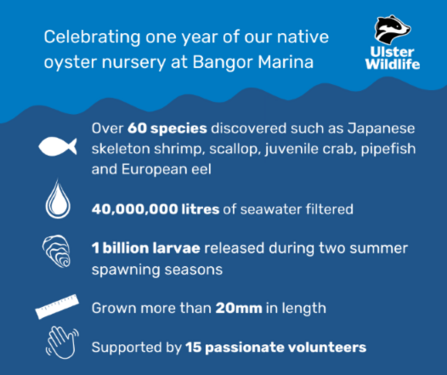
Celebrating a biodiversity boom for Bangor on World Oyster Day
The native oyster nursery will release millions of larvae into Belfast Lough, boosting the endangered species, creating natural reefs for other marine wildlife and cleaning gallons of seawater every day.

Background to Ireland's first native oyster nursery
The native oyster (Ostrea edulis) was found in vast beds throughout Belfast Lough until the mid-1800s. Overfishing, disease, invasive species, and pollution decimated the population, and by 1903 the native oyster was considered extinct. If you look closely while walking around the Lough, you can still see the remnants of their shells on the seabed and along the shoreline. In 2020, a small population of live native oysters were discovered on Belfast Lough’s shore for the first time in over 100 years.
To help restore the once prolific oyster, Ulster Wildlife deployed the first native oyster nursery in Ireland at Bangor Marina, in April 2022, thanks to funding from the Department of Agriculture, Environment and Rural Affairs. Twenty-four purpose-built oyster cages stocked with 600 mature native oysters, sourced under licence from Loch Ryan in Scotland, were suspended under the marina’s pontoons.
Biodiversity boom
A year on and the nursery is now well established with the oysters and cages hosting a vast array of marine life. Volunteers and staff have identified over 60 species including Japanese skeleton shrimp, common prawn, juvenile crab, pipefish, lumpsuckers, tompot blennies, spined stickleback fish and, on two occasions, the critically endangered European eel. As the tide moves in and out of the marina, water flows through the cages hanging beneath the pontoon, making it a sanctuary for filter feeders such as tubeworms, scallops, saddle oysters, and mussels with ruffled white and purple egg cases from nudibranchs taking refuge along the edges of the cages. As the oyster nursery grows and matures over the years to come, we envisage a lot more species being discovered within these unique hanging mini reef systems.
Wider benefits to the environment
The oysters have also provided some impressive ecosystem services over the last year, such as improving water clarity within Bangor Marina by filtering seawater. A single adult oyster has the ability to filter 200 litres of seawater a day and the Bangor oysters have filtered a staggering 40,000,000 litres in their first year filtering phytoplankton, excess nutrients, micro-plastics and pollutants from the water column. These qualities could greatly improve the water ratings of our coastal and estuarine regions, which are often subject to increased nutrient loading from agricultural and sewage run-off.
Restoration of lost oyster reefs on the seabed
During the summer months, the oysters in the nursery began to release larvae into the water column, which will settle on the seabed forming oyster reefs. Oyster reefs are recognised as priority habitats, providing nursery grounds for fish and shelter for numerous marine creatures. The potential for species-diverse reef structures can already be seen at Bangor Marina where the oysters and cages have created dynamic spaces and surfaces supporting a multitude of species both mobile and sessile (fixed). Essentially the cages create a hanging artificial reef structure enhancing the biodiversity within the marina. A further benefit the oysters provide is one of carbon capture; as the oysters grow their shells store excess carbon from the environment which will help tackle the climate crisis.
Despite their small size and insignificant appearance, it is clear that native oysters bring huge benefits to our marine environment in a relatively short time. This is a win-win for nature: restoring native oysters creates healthier seas, richer in wildlife and more resilient to climate change.
Find out more about native oysters and our work to restore these ocean superheroes





